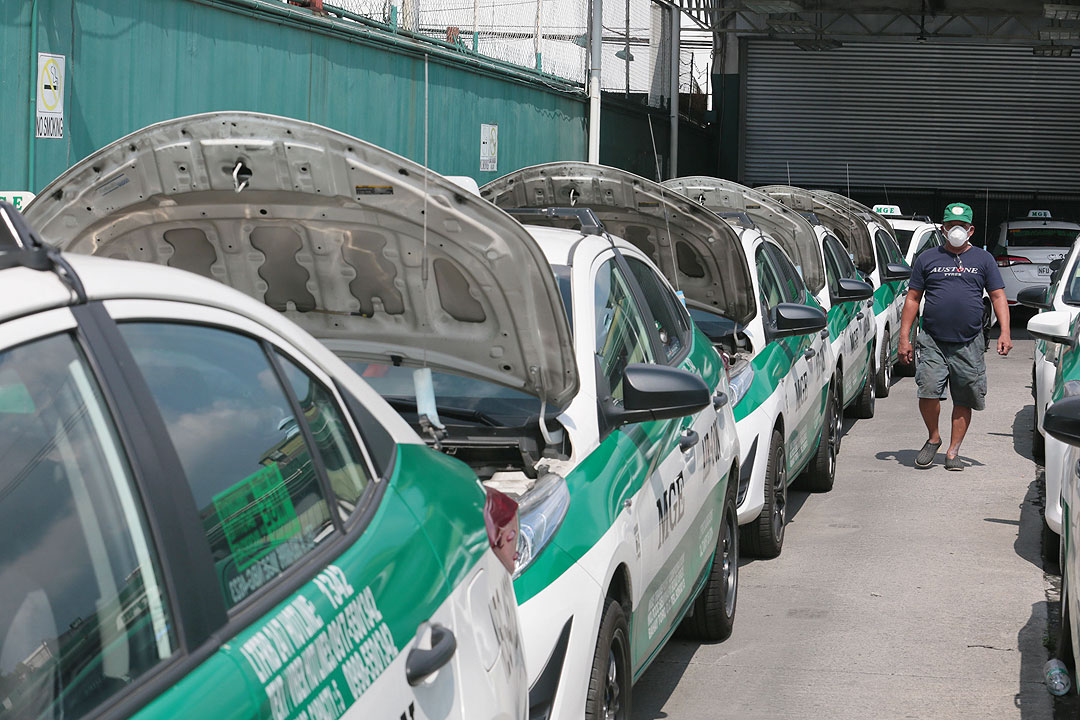
By Arjay L. Balinbin, Senior Reporter
ANACITO C. OTILLA, JR., 49, makes less than P300 a day driving a taxi around Manila, the capital and nearby cities.
That’s five times less than what he earned before a coronavirus pandemic hit the world.
“Some of my friends are no longer in the business,” Mr. Otilla, who has been driving a cab for nine years, said in an interview in Filipino. “I’m afraid it’s not going back to normal anytime soon.”
 Various levels of lockdowns spurred by the pandemic in the past 19 months have made it even more difficult for an industry already hit hard by increased competition from ride-hailing services such as Grab.
Various levels of lockdowns spurred by the pandemic in the past 19 months have made it even more difficult for an industry already hit hard by increased competition from ride-hailing services such as Grab.
These days, less than a third of operators’ taxis go out to look for passengers, who are mostly at home, Quezon City Rep. Jesus Manuel C. Suntay said by telephone.
“Few drivers want to go out because they barely earn due to the lockdowns and curfews,” said the congressman, who is also president of the Philippine National Taxi Operators Association. “That’s been happening for the past 19 months already.”
Active taxis had almost been halved to 27,934 units as of last month from 50,059 units before President Rodrigo R. Duterte locked down the entire Luzon island in mid-March last year to contain the virus, according to data from the Land Transportation Franchising and Regulatory Board.
The regulator has received 15 franchise applications for 630 regular taxis this year, down from 26 applications for 1,201 units last year. It only received one franchise application for 30 premium taxi units compared with two applications for 67 units last year.
The agency said 4,453 franchise slots were still available for premium taxis and 6,211 slots for regular taxis.
Mr. Suntay, who is also president of Basic Transport Management Corp., said it would probably take more time for the economy to recover from the pandemic.
The logical move for most operators is to shrink their fleets to cut losses, he said, adding that they would need at least four years to become profitable again.
The Philippine economy shrank by 9.6% last year, one of the worst in Asia and the Philippines’ deepest recession since World War II, after it enforced one of the longest and strictest lockdowns in the world. Fitch Ratings in July changed its credit rating outlook for the country to “negative” from “stable.”
Taxi business could barely survive even with the gradual reopening of the economy, especially amid rising fuel prices, Mr. Suntay said. “There are fewer passengers, fuel costs are up but fares have not moved up.”
Local gasoline prices, which are due for a P1.15 a liter increase this week, have risen for nine straight weeks.
TOUGH TIMES
Mr. Suntay said some taxi operators have been forced to sell unused taxis during the pandemic. Operators also continue to pay for the insurance of their unused units.
Allan Montenegro, 47, felt relieved when his operator lowered the daily boundary fee from P1,000 to just P600 on weekdays and P500 on weekends.
He used to earn P1,500 on a good day before the crisis, just enough to support three kids.
“Now, I’d be happy to earn P500 a day,” he said while taking coffee break in front of a closed provincial bus terminal in Cubao on a Sunday night.
The cab driver has chosen not to join Grab because of the “tedious process.” “I know some people who drive under Grab. And I know for a fact that some passengers end up calling a regular taxi when Grab rates are too high.”
Mr. Suntay said fleet consolidation for the taxi industry doesn’t make sense, especially for operators with hundreds of units.
“It will not change the fact that many are still not operating at 100% capacity,” he said. “If a taxi operator has a thousand units, whom will he consolidate with?”
An interagency task force last week approved a plan to increase passenger capacity in road- and rail-based public transportation in Metro Manila and nearby provinces from 70% to full capacity starting Nov. 4.
The Department of Transportation on Friday said it would gradually increase the passenger capacity of public transportation in Metro Manila starting this week.
The agency cited greater demand for public transport after businesses were allowed to operate at increased capacity and as more Filipinos get vaccinated against the coronavirus.
Mr. Suntay said the government should waive regulatory fees for unused taxis.
Land Transportation Franchising and Regulatory Board Chairman Martin B. Delgra III last month said the agency had waived penalties for public utility vehicle operators who did not immediately apply for an extension or renewal of their franchises.
Transport expert Rene S. Santiago noted that before the pandemic, taxis took about a tenth of daily trips in Metro Manila. “The biggest part of the demand that was lost came from the schools that are still closed,” he said, adding that these accounted for about four million trips a day.
The pre-pandemic level of demand is unlikely to return soon because schools and businesses would continue to implement a hybrid setup. “Ultimately, whether they like it or not, taxis will have to be part of the ride-hailing network to survive,” he said.
Mr. Santiago said apps allow taxi drivers to identify where the demand is instead of wasting time and fuel looking for passengers. “Technology connects demand to supply in the shortest time possible. That’s the way to go.”
Mr. Suntay said the regular taxi business would remain viable despite the crunch.
“Eventually, either the coronavirus pandemic will end or we’d learn how to live with it,” he said. “There will still be a need for regular taxis, as shown by the experience of Europe and the United States.”
Mr. Otilla, the taxi driver, said he doesn’t have a choice but to slug it out.
“These are difficult times, but this is the only job I know. A good day these days might be limited to paydays, but hopefully I can get by.”
Taxis drive through ghost town of darkened bars and shops shuttered by coronavirus pandemic
Source: Bantay Radio
0 Comments